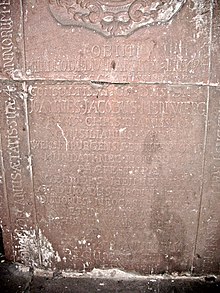Johann Jakob Menweeg
Johann Jakob Menweeg (* 1636 ; † November 11, 1694 in Weißenburg , Alsace ) was the royal French prefect in Hagenau and Weißenburg as well as the founder of the Catholic parish of Schweigen (Palatinate) .
Origin and family
The Menweeg family came from Pfirt ( Ferrette ) in Upper Alsace, until 1648 the capital of the Austrian county of Pfirt , which fell to France that year.
His brother Johann Philipp Menweeg († 1702) was Stiftsdekan in Landau and commissioner of the Speyer Bishop for Weißenburg and the southern Palatinate.
The sex belonged to the French nobility and appears more often as "de Menweeg" . The family coat of arms is u. a. on the tombstone of the Landau monastery dean Johann Philipp Menweeg and is described as follows: “Under an aristocratic crown, framed by palm branches, divided in blue and gold, top with two silver stars, below with a blue rafter and two silver crossed arrows. "
Live and act
Johann Jakob Menweeg entered the service of the French king and became prefect of Haguenau and Weißenburg in the lower Alsace as part of his reunion policy . According to the funerary inscription, he was also a privy councilor of King Ludwig XIV and his Oberamtmann in Germersheim , since this Oberamt in the Electoral Palatinate fell to France in 1682. In addition, the text of the gravestone shows that Menweeg also acted as governor of Duke Gustav Samuel Leopold von Pfalz-Zweibrücken-Kleeburg , who converted to Catholicism (probably in his Alsatian possessions, which were subject to French sovereignty).
In the spring of 1689, shortly before the fire in Speyer during the War of the Palatinate Succession , Johann Jakob Menweeg was sent there to secure the archives of the diocese, the city and the Imperial Court of Justice for France.
The French reunification policy was also associated with a re-Catholicization of the area. Johann Jakob Menweeg, who came from a decidedly Catholic family, donated 20,000 guilders from his private fortune around 1685 in order to reestablish the Catholic parish of Schweigen, which disappeared during the Reformation.
Menweeg was married to Marie Barbara geb. Scherb from Colmar , with whom he had six children. Her son Franz Xaver Michael became a Catholic priest. The daughter Maria Magdalena married the baron Franz Heinrich von Neubeck (1658–1727), bishop of Speyer in Kirrweiler , whose damaged tombstone has been preserved in the cloister of the Abbey Church in Weißenburg .
Johann Jakob Menweeg died on St. Martin's Day 1694 in Weißenburg and was buried in the abbey church. His damaged tombstone is also in the cloister there , the coat of arms has been smashed. It is the second use of an older grave slab.
literature
- Ludwig Stamer : Church history of the Palatinate , 3rd part, 2nd volume, p. 15 u. 17, Pilger Verlag Speyer, 1959;
Web links
Individual evidence
- ↑ Wolfgang Mecklenburg: Ex libris: Book Art and Applied Graphics , Volume 19, p. 32, 1909; (Cutout scan 1) , (Cutout scan 2)
- ↑ Johannes von Geissel : Der Kaiser-Dom zu Speyer: A topographical-historical monograph , Volume 3, p. 11 u. 14, Speyer, 1828; (Digital scan)
- ↑ Michael Frey : Attempt at a geographical-historical-statistical description of the royal Bavarian Rhine district Volume 1, p. 258, FC Neidhard, Speyer 1836; (Digital scan)
- ^ Ernst Heinrich Kneschke: New general German Adels Lexicon , Volume 6, Leipzig, 1865, p. 478; (Digital scan of the von Neubeck family)
- ^ Website of the tombstone in Weißenburg
| personal data | |
|---|---|
| SURNAME | Menweeg, Johann Jakob |
| BRIEF DESCRIPTION | royal French prefect, founder of the catholic parish of Schweigen (Palatinate) |
| DATE OF BIRTH | 1636 |
| DATE OF DEATH | November 11, 1694 |
| Place of death | Weissenburg , Alsace |


